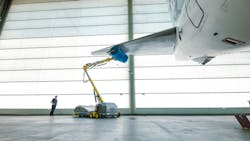Aircraft Corrosion – A Problem Out of Thin Air
Many older cars share a common problem among themselves – corrosion on the body and panels of the automobile. The same problem, surprisingly, when maintained incorrectly applies to older aircraft too. Jan Brunstedt, the CEO of Aviator Robotics AB, the creator of the Nordic Dino aircraft exterior washing robot, explains why corrosion is such an important topic in the world of aviation.
What causes corrosion?
A short and easy answer would be metal coming in contact with water, but the question also requires a longer and more in-depth explanation to have the full picture of the problem. To understand the topic better, let us begin with some examples from everyday life.
“During most winters in Nordic regions, a common practice involves the use of runway de-icing fluid and salt to avoid icing on runway and apron. At that time, it is a normal sight to see cars covered in white substance which in turn is the same salt that is used to prevent icing and break it down. The salt, while harmless to the environment, still has chemical properties to break down paint and expose small portions of metal to air and humidity. As a result, a couple of years down the line, the car’s body begins corroding and rusting unstoppably. The same applies to aircraft when being stationed near salty waters,” says Jan Brunstedt.
Airlines that have aircraft stationed only tens of kilometres away from the sea have salty air from oceans and seas reaching aircraft fuselages and slowly decomposing paint as well as protective coatings. That is why some call this issue – a problem out of thin air.
Why is it important to prevent corrosion?
Corrosion is a fast and irreversible process that impacts the structural integrity of an aircraft. The keywords in that sentence are fast and irreversible. “One of our customers told us a story involving the transportation of salted fish. The freight was always placed in the luggage compartment which after 6 months due to the salty nature of the product became corroded and caused damage to the aircraft structure. I was surprised to see how much damage can be done in such a short amount of time. It once again showed the importance of corrosion-preventive measures,” comments Jan.
Pavlo Mykhailenko, Head of Structure Shop at JETMS, a global one-stop-shop MRO for business and regional aircraft, explains that “Inspection for corrosion must be a routine practice as part of the normal maintenance program, independently of the scheduled tasks of the Corrosion Prevention and Control Program. The early detection of corrosion signs is very important to permit prompt corrective action and render the corrosion control more efficient. This could reduce costs, out-of-service time, and the possibility of flight-related incidents. It is also important that the inspection be followed by the correct treatment of the affected areas.”
What corrosion-preventive measures are there?
Jan emphasizes that “there is no other way to prevent corrosion than regularly washing aircraft.” According to him, the modern aircraft are partly built with composite material and require more intense crack inspections and more frequent washing. “Boeing recommends performing crack and rust checks 4 times per year; hence those are the only instances when airlines wash aircraft to save on cleaning costs. Yes, in the short term the practice seems logical, but in the long-term corroded aircraft will require much more maintenance, time, and effort to serve and not be deemed ‘out of service’. In our experience, the focus is slowly shifting and airlines are giving more and more attention to this problem which even required us to start a new service to cope with the demand and time-sensitive situations. As many airlines do not want to invest large sums of money into the training of personnel and equipment, we fly out our trained operators to perform all cleaning duties which has saved airlines time and money when compared to traditional washing methods. Now, the resources that previously could allow only 1 wash, allow 2 or 3 for the same amount of work and washing solutions,” concludes Jan Brunstedt.
